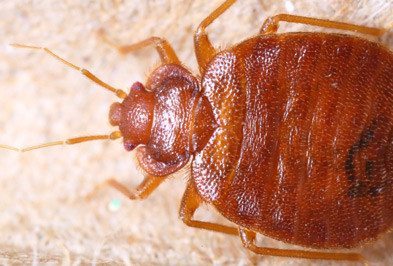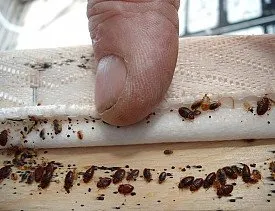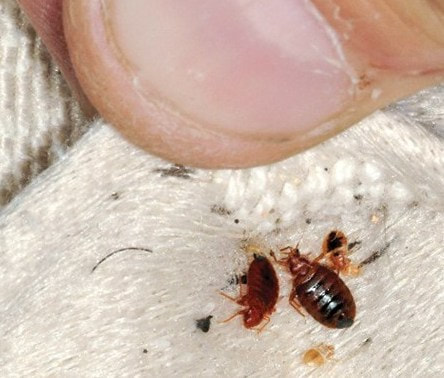Experienced DC Exterminator for Bed Bug Heat Treatment Near Me
Experienced DC Exterminator for Bed Bug Heat Treatment Near Me
Blog Article
Introduction the Power of Bio-Fungicide Sprays in Targeting Bed Pest Infestations Normally
In the realm of pest control, the persistent and elusive nature of bed pest problems postures a substantial difficulty for professionals and property owners alike. Traditional approaches usually include extreme chemicals that can be damaging to health and wellness and the atmosphere. Nonetheless, a promising alternative has actually arised in the form of bio-fungicide sprays (bed bug heat treatment). These natural options take advantage of the power of helpful fungi to deal with bed bugs successfully. As we look into the complexities of their mechanism of action and the engaging advantages they offer, a more clear understanding of their potential in addressing this typical hassle unfolds.
Bio-Fungicide Sprays: A Natural Remedy
When combating bed insects, bio-fungicide sprays use an all-natural solution that is increasingly gaining appeal due to their effectiveness and eco-friendly nature. Bio-fungicides are originated from naturally happening microorganisms such as fungis, bacteria, and various other organic sources. These sprays work by targeting the bed pests' exoskeleton, disrupting their development and recreation cycle, ultimately resulting in their demise.

Furthermore, bio-fungicide sprays are much less likely to add to chemical resistance in bed insect populaces, as they use different settings of action that are not quickly adapted to by these parasites - bed bug treatment. This makes them a useful tool in integrated pest administration techniques targeted at removing and regulating bed insects in a sustainable fashion
Understanding Bed Insect Infestations
What variables add to the spread of bed insect infestations in urban atmospheres? Bed bug invasions flourish in metropolitan setups because of a number of key factors. One substantial factor is the high populace thickness in cities, which supplies ample chances for bed bugs to spread out from one area to an additional with human activity. The frequent traveling and movement of individuals within and between city areas also play an important duty in the rapid dissemination of bed pests. Additionally, the frequency of multifamily real estate units and shared home in metropolitan environments produces adjoined networks that promote the spread of bed pests between devices or buildings.
Furthermore, the raised mobility of individuals and the widespread use secondhand furniture and items in metropolitan settings can introduce bed pests right into brand-new settings, sustaining infestations. Lack of recognition and proper education regarding bed pest avoidance and control steps further worsen the spread of invasions in city locations. Understanding these elements is essential for creating effective techniques to protect against and combat bed bug invasions in urban atmospheres.
Mechanism of Bio-Fungicide Action

Additionally, some bio-fungicides function by damaging the fungal cell membrane, causing leakage of vital mobile elements and triggering the cell to collapse. This disruption of the cell membrane layer honesty jeopardizes the fungal cell's viability and adds to its demise. Furthermore, bio-fungicides can induce oxidative anxiety within the this fungal cell, activating a waterfall of damaging reactions that finish in cell death.
Benefits of Utilizing Bio-Fungicides

One visit this site more advantage of bio-fungicides is their ability to combat chemical resistance. Over time, insects like bed bugs can establish resistance to chemical pesticides, rendering them ineffective. Bio-fungicides supply a different mode of action, making it less most likely for parasites to develop resistance and ensuring long-term performance in pest control. Bio-fungicides have very little to no residual effects on the environment, lowering the danger of damaging chemicals lingering in the environment. On the whole, the benefits of making use of bio-fungicides in pest monitoring expand beyond simply regulating fungal illness, supplying a reliable and sustainable alternative to typical chemicals.
Application Tips for Effective Outcomes
To achieve optimum outcomes when utilizing bio-fungicide sprays for bed pests, correct application methods are important for efficient parasite control. Target these locations straight with the bio-fungicide spray, concentrating on splits, gaps, and various other hiding spots where bed pests are most likely to dwell.
Moreover, it is recommended to comply with the producer's instructions relating to the dilution proportion and application frequency to optimize the bio-fungicide's efficiency without creating injury to people or pet dogs. Uniformity in application is vital to breaking the bed insect life process and stopping reinfestation. Additionally, take into consideration turning different kinds of bio-fungicides to prevent the development of resistance in bed bug populations.
Lastly, it is vital to keep sanitation and declutter the treated locations to get rid of prospective bed insect hiding areas and assist in the bio-fungicide's performance. Regular tracking and reapplication, if required, will help make sure lasting success in getting rid of bed insects normally.
Final Thought
To conclude, bio-fungicide sprays provide an all-natural solution for targeting bed pest infestations. By comprehending the device of bio-fungicide action and the benefits of making use of these items, individuals can successfully fight bed insects without making use of damaging chemicals. Complying with proper application pointers can bring about successful cause managing bed pest infestations in a site secure and environmentally-friendly way.
Furthermore, bio-fungicides have shown promising results in successfully getting rid of bed pest infestations, providing a sensible alternative to conventional approaches.
To accomplish optimum results when making use of bio-fungicide sprays for bed insects, correct application techniques are crucial for effective bug control. Furthermore, consider turning various kinds of bio-fungicides to protect against the growth of resistance in bed bug populations.
In final thought, bio-fungicide sprays use an all-natural option for targeting bed pest problems. By comprehending the device of bio-fungicide activity and the benefits of making use of these items, people can properly battle bed bugs without the use of damaging chemicals.
Report this page